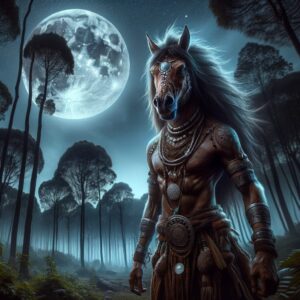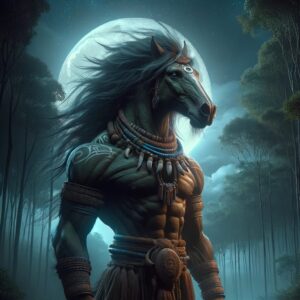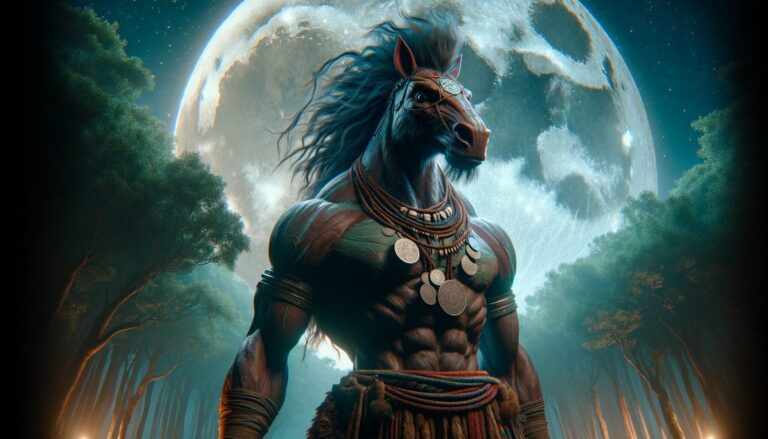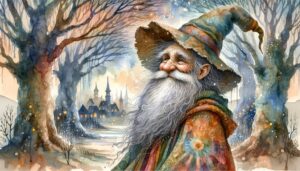Table of Contents
In the enchanted realm of Filipino folklore, where the lush rainforests whisper ancient secrets and the emerald rice fields sway in harmony with the winds, there exists a mythical creature known as the Tikbalang. As we embark on this mystical journey into the heart of Filipino mythology, we will unravel the intricate tapestry of the Tikbalang’s existence, exploring its origins, family ties, fearsome appearance, extraordinary abilities, and the profound cultural impact it has had on the people of the Philippines. But our exploration goes beyond mere facts; it delves into the symbolic interpretations, cultural significance, thematic exploration, and vivid descriptions that make the Tikbalang a captivating and enigmatic figure in the world of myths and legends.
A humanoid creature with the head of a brown or black horse from Philippine myth. He stalks on travellers in the forest and follows them in a manner that no matter how the traveller tries to evade the Tikbalang, the monster will always be near. The Tikbalang has the ability to transform into a human and if desired into a human that is known to its victim. To avoid the Tikbalang, one must where their shirt inside out or occasionally ask permission out loud to pass through and then tread quietly as not to disturb the beast.

Origins and Family
The rich cultural heritage of the Philippines deeply roots the Tikbalang. Its name originates from two Filipino words: “tik” means “to snap,” and “balang” means “joke” or “prank,” reflecting its mischievous nature. Although it appears as a simple prankster, its origins are more complex.
In Filipino mythology, the Tikbalang is believed to be the offspring of the powerful and fearsome moon deity, Bathala, and a mortal woman. This divine lineage bestows upon the Tikbalang a unique status among mythical creatures, merging the celestial and earthly realms. Bathala, the moon deity, fell in love with a beautiful woman, granting her the gift of motherhood. The child born from this union inherits ethereal qualities, resulting in the Tikbalang’s supernatural existence.
Appearance
The Tikbalang’s physical appearance is a source of both awe and trepidation. Standing at an imposing height, often described as being as tall as the tallest trees, it has a slender but sturdy frame covered in dark, matted fur. Its most distinguishing feature is its equine head, reminiscent of a horse, with wild, fiery red eyes that gleam with an otherworldly intelligence. Sharp, elongated teeth gleam menacingly beneath its equine snout, and its long, bony fingers end in claws that can effortlessly rend flesh and bone.
The Tikbalang’s disproportionately long legs resemble a horse’s, granting it supernatural speed and agility, allowing it to traverse great distances in a blink. Its webbed, duck-like feet produce a distinctive clicking sound as it navigates forests and mountains.
Abilities

The Tikbalang possesses an array of formidable abilities that elevate it above mere prankster status and make it a force to be reckoned with in Filipino folklore.
Shapeshifting: One of its most astonishing abilities is shapeshifting. The Tikbalang can assume the form of anyone it desires, often taking on the appearance of a trusted friend or family member. This uncanny talent makes it particularly dangerous, as it can lure unsuspecting victims into its web of trickery and deceit.
Illusions: The Tikbalang is a master of illusion, capable of creating incredibly realistic and beguiling hallucinations. It uses this power to disorient and terrify travelers, leading them astray in the dense forests or treacherous mountain passes.
Mind Manipulation: Another disturbing ability of the Tikbalang is its power to control the thoughts and emotions of its victims. It can induce fear, confusion, and paranoia, further exacerbating the disorientation of those it encounters.
The Tikbalang closely associates with natural elements, especially rain and thunderstorms. Belief holds that it can summon heavy rains and thunderstorms, infusing its pranks with an ominous and foreboding atmosphere.
In certain versions of the Tikbalang myth, it possesses the power to create whirlwinds or vortexes, which can whisk its victims away to an unknown fate. This introduces a supernatural and uncanny dimension to its array of abilities.
Symbols and Cultural Impact
The Tikbalang, with its distinctive appearance and mischievous nature, has left an indelible mark on Filipino culture and folklore. Its symbolism goes beyond the superficial, offering a profound exploration of human fears, the mysteries of the natural world, and the interplay between the divine and the mortal.
The Tikbalang symbolizes the unknown and the uncontrollable forces of nature. Furthermore, its ability to manipulate the elements, create illusions, and control minds reflects the primal fears humans have of the natural world’s unpredictability. Additionally, it serves as a reminder of the dangers lurking in the wilderness, urging travelers to approach the wild with caution and respect.
Moreover, the Tikbalang embodies the duality of human nature. Just as it is the child of a divine being and a mortal, it represents the juxtaposition of the celestial and the earthly within every person. This duality suggests that humans, like the Tikbalang, possess both light and dark aspects, capable of acts of kindness and cruelty.
The Tikbalang’s mischievous tricks also serve as a metaphor for life’s unexpected challenges and obstacles. Just as travelers must navigate the Tikbalang’s pranks, people must overcome unexpected trials and tribulations in their own journeys. The creature’s ability to shape-shift into trusted figures mirrors the betrayal and deceit that can sometimes lurk within even the closest relationships, reminding us to be vigilant and discerning.
Myths and Stories
Countless myths and stories about the Tikbalang have been passed down through generations in the Philippines. These tales often revolve around encounters with the creature and the lessons learned from these interactions.
In one popular story, a group of travelers becomes lost in a dense forest. The Tikbalang, taking on the form of one of their companions, leads them deeper into the wilderness, playing tricks on them all along the way. Eventually, the travelers realize the deception and manage to escape, learning to trust their instincts and not be swayed by appearances.
Another tale tells of a courageous hunter who encounters a Tikbalang in the mountains. Despite the creature’s attempts to confuse him with illusions, the hunter remains steadfast, relying on his wits and bravery to outsmart the Tikbalang. This story emphasizes the importance of resilience and mental fortitude in the face of adversity.
Another myth portrays the Tikbalang as a guardian of the forest and its inhabitants, particularly animals. It punishes those who harm nature, emphasizing the interconnectedness of all living beings and the necessity of environmental stewardship.
Conclusion
The Tikbalang, with its enigmatic origins, fearsome appearance, and powerful abilities, is a captivating figure in Filipino mythology. Moreover, its symbolism and cultural impact run deep, offering insights into the human psyche, the mysteries of nature, and the complex interplay between the divine and the mortal. Furthermore, through its myths and stories, the Tikbalang imparts valuable lessons about trust, resilience, and environmental responsibility. As we journey through the lush landscapes of Filipino folklore, the Tikbalang stands as a testament to the enduring power of myths and the timeless wisdom they hold for generations to come.
FAQ
What does Tikbalang mean?
The word Tikbalang is derived from "tik," meaning "to snap," and "balang," meaning "joke" or "prank."
What is the Tikbalang's appearance?
It has a horse-like head, fiery red eyes, and disproportionately long legs.
What abilities does the Tikbalang possess?
It can shapeshift, create illusions, manipulate minds, control the elements, and even create vortexes.
What does the Tikbalang symbolize?
It symbolizes the unknown and the uncontrollable forces of nature, as well as the duality of human nature.
What are some Tikbalang myths?
Stories depict it as a trickster, a protector of the forest, and a guardian of animals.
What lessons can be learned from Tikbalang myths?
Tikbalang myths often teach lessons about trust, resilience, and environmental responsibility.
How does the Tikbalang impact Filipino culture?
It has a deep cultural impact, influencing art, stories, and cautionary tales about the wilderness.




